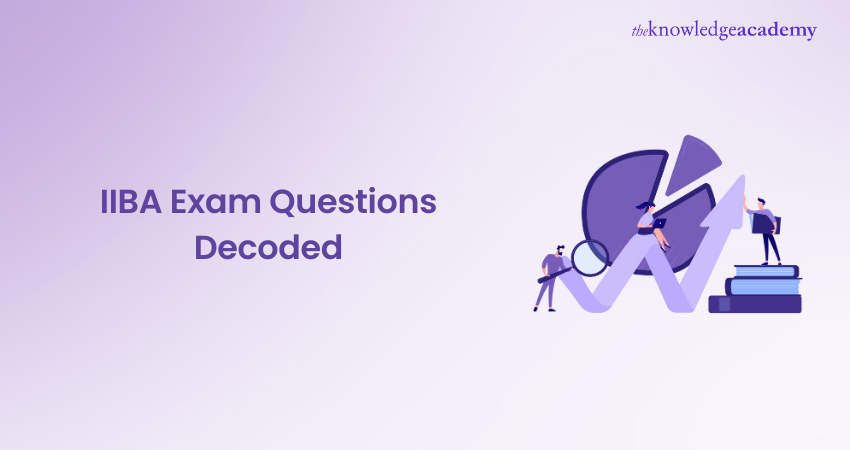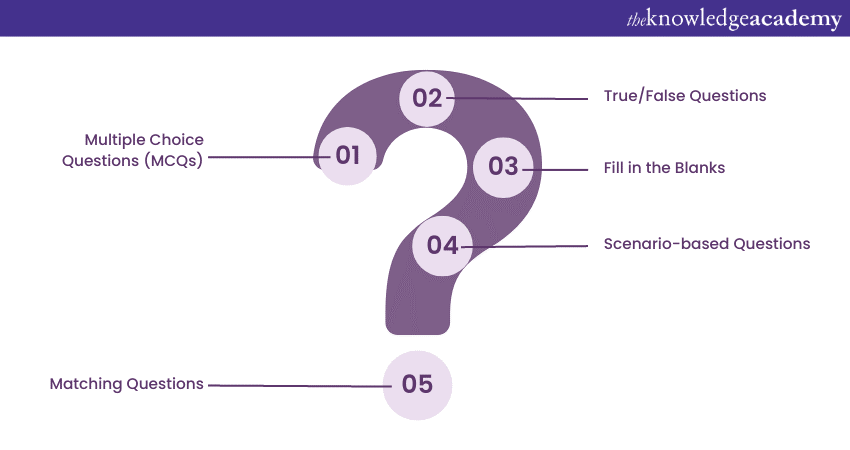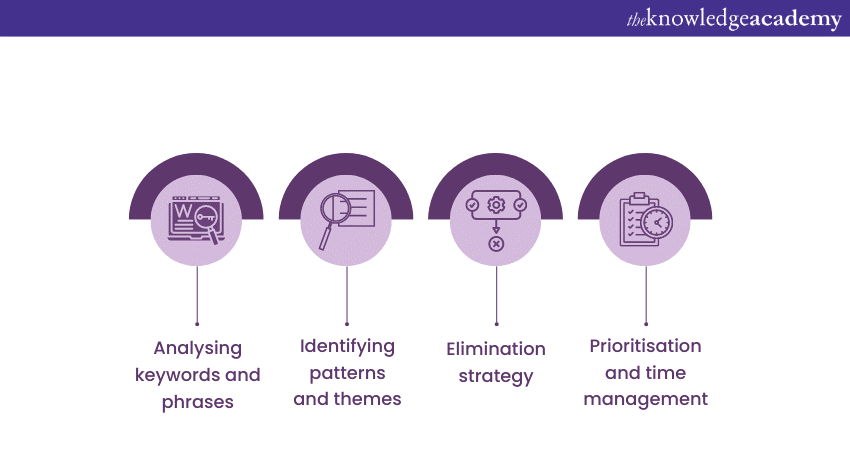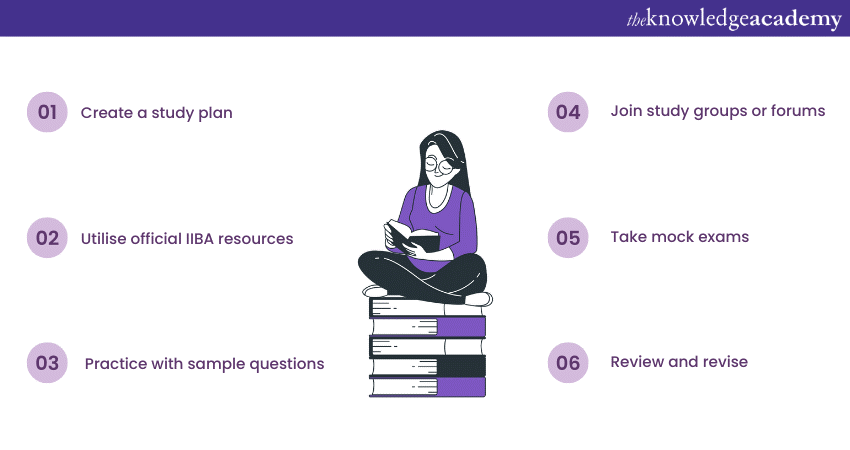We may not have the course you’re looking for. If you enquire or give us a call on 01344203999 and speak to our training experts, we may still be able to help with your training requirements.
Training Outcomes Within Your Budget!
We ensure quality, budget-alignment, and timely delivery by our expert instructors.

Aspiring business analysts and professionals preparing for IIBA Certifications often face the daunting challenge of deciphering complex exam questions. That's why we're here to help! This blog is dedicated to unravelling the mysteries of IIBA Exam Questions and serving as your trusted study companion.
In the field of Business Analysis, IIBA Certifications hold immense value, showcasing your expertise and knowledge in the field. But let's be honest, the journey to obtaining these certifications can be a bit overwhelming, especially when confronted with intricate exam questions. That's precisely why we've created this blog – to be your guiding light, providing insights into different question types and equipping you with powerful decoding techniques that will catapult your exam performance to new heights. So, whether you're gearing up for the ECBA (Entry Certificate in Business Analysis), CCBA (Certification of Capability in Business Analysis), or CBAP (Certified Business Analysis Professional) exams, rest assured that this study companion has got your back!
Table of Contents
1) Understanding the IIBA Certification Exams
2) Common question types in IIBA Exams
3) IIBA Exam Questions decoding techniques
4) Study tips for IIBA Exam preparation
5) Case studies: Sample IIBA Exam Questions
6) Resources for further learning
7) Conclusion
Understanding the IIBA Certification Exams
In this section, you’ll gain insight into the structure, content, and requirements of the IIBA Certification Exams, empowering you to effectively prepare and succeed in your journey towards becoming a certified business analyst.
Overview of IIBA Certifications
The International Institute of Business Analysis (IIBA) offers a range of certifications that validate the skills and knowledge of business analysts. These certifications are recognised globally and serve as a testament to an individual's expertise in the field of Business Analysis. The most widely pursued IIBA Certifications include the Entry Certificate in Business Analysis (ECBA), Certification of Capability in Business Analysis (CCBA), and Certified Business Analysis Professional (CBAP).
Each certification level has specific requirements, such as work experience and professional development hours, which candidates must fulfil to be eligible for the exam. The exams assess a wide range of competencies, including Business Analysis planning and monitoring, elicitation and collaboration, requirements life cycle management, strategy analysis, and more. Understanding the structure and content of the certification exams is crucial for effective preparation.

Importance of exam question decoding
Decoding exam questions is a vital skill that can significantly impact your performance in the IIBA Certification Exams. These exams often present complex scenarios and require candidates to apply their knowledge to real-world Business Analysis situations. By decoding the questions, you can gain a deeper understanding of what is being asked and select the most appropriate answer choice.
Decoding exam questions involves analysing keywords, identifying patterns, and discerning the underlying concepts being tested. It enables you to navigate through the distractors and choose the best response that aligns with IIBA's standards and practices. Developing this skill will not only boost your confidence but also increase your chances of selecting the correct answer, ultimately leading to success in the IIBA Certification Exams.
Unlock your potential as a certified Business Analysis professional and pave your path to success with our expert-led IIBA Certified Business Analysis Professional (CBAP) training.
Common question types in IIBA Exams
In this section, you’ll discover the common question types encountered in IIBA Exams, including multiple choice, true/false, fill in the blanks, scenario-based, and matching questions, equipping you with the knowledge to navigate and excel in your exam preparation.

1) Multiple Choice Questions (MCQs)
Multiple Choice Questions are a prevalent question type in IIBA Exams. Candidates are presented with a question followed by several answer choices. The task is to select the most appropriate answer among the given options. These questions may assess various aspects of Business Analysis, including knowledge of concepts, tools, techniques, and best practices. It is essential to carefully read and analyse each option to make an informed choice.
2) True/False Questions
True/False questions are designed to test your understanding of specific statements related to Business Analysis. You will be presented with a statement, and you must determine whether it is true or false. These questions often require careful evaluation of the statement in the context of Business Analysis principles and practices. Pay attention to keywords and qualifiers that can change the validity of the statement.
3) Fill in the Blanks
In Fill in the Blanks questions, a sentence or paragraph is provided with one or more blanks. Your task is to fill in the missing words or phrases to complete the sentence or paragraph correctly. These questions assess your knowledge of terminology, key concepts, and their application in Business Analysis. Ensure you understand the context and use clues from the surrounding text to deduce the appropriate answer.
4) Scenario-based Questions
Scenario-based questions present a Business Analysis scenario or situation, followed by a question related to that scenario. Candidates are required to analyse the given information and apply their knowledge to select the best course of action or answer. These questions test your ability to think critically, apply Business Analysis techniques, and make informed decisions in practical situations.
5) Matching Questions
Matching questions involve pairing items from two columns. One column consists of statements, descriptions, or terms, while the other column contains corresponding options or categories. Your task is to match the items correctly based on their association. These questions assess your understanding of Business Analysis concepts, frameworks, techniques, or artefacts and their appropriate use in different contexts.
Familiarising yourself with these common question types will help you prepare effectively for IIBA Exams. By understanding the unique requirements of each question type, you can develop appropriate strategies and approaches to tackle them successfully.
Take your Business Analysis skills to new heights and earn the esteemed CCBA certification with our comprehensive IIBA Certification of Competency in Business Analysis (CCBA) training program.
IIBA Exam Questions decoding techniques
In this section, we’ll discuss the key techniques for decoding IIBA Exam Questions, including analysing keywords, understanding question structure, employing elimination strategies, and drawing on subject knowledge, enabling you to approach IIBA Exams with confidence and accuracy.

1) Analysing keywords and phrases
One effective technique for decoding exam questions is to carefully analyse the keywords and phrases within the question. Pay close attention to terms that indicate specific actions, such as "identify," "evaluate," or "recommend." These keywords provide insights into what is being asked and guide you towards the correct approach or answer. Similarly, focus on phrases that provide context or constraints, as they can help you narrow down the options and eliminate irrelevant choices.
2) Identifying patterns and themes
Exam questions often exhibit patterns or recurring themes, especially when it comes to certain concepts or areas of Business Analysis. By recognising these patterns, you can anticipate the types of questions that may be asked and prepare accordingly. Look for similarities in structure, wording, or content across practice questions or previous exams. This technique allows you to familiarise yourself with common question patterns and saves you time and effort during the actual exam.
3) Elimination strategy
When faced with multiple-choice questions, an effective strategy is to use the process of elimination. Start by eliminating options that are clearly incorrect or unrelated to the question. Carefully evaluate the remaining choices, comparing them to the requirements or principles of Business Analysis. Often, there will be subtle differences that can help you identify the most accurate or appropriate response. This technique increases your chances of selecting the correct answer even if you are unsure about the absolute certainty of a particular option.
4) Prioritisation and time management
Time management is crucial during the exam, and it is essential to allocate your time wisely across different questions. As you decode the questions, assess their complexity and allocate more time to those that require deeper analysis or calculations. Prioritise your efforts based on the potential value of each question. If you encounter a particularly challenging question, make a note to revisit it later and proceed to other questions that you can answer with confidence. This technique ensures that you maximise your overall score by effectively utilising the available time.
Master the art of Business Analysis with our industry-leading Business Analysis training courses and drive transformative change in any organisation.
Study tips for IIBA Exam preparation
You can enhance your IIBA Exam preparation with these valuable study tips:

1) Create a study plan
Develop a structured study plan that outlines your study goals, timelines, and topics to cover. Breaking down the exam content into smaller, manageable sections helps you stay organised and ensures comprehensive coverage of the material. Allocate dedicated study time each day or week, and stick to the plan to maintain consistency and progress in your preparation.
2) Utilise official IIBA resources
Make use of the official IIBA resources, including the BABOK Guide (Business Analysis Body of Knowledge), exam syllabus, and sample questions. These resources provide valuable insights into the exam content, knowledge areas, and the IIBA's recommended best practices. Familiarise yourself with the official resources to align your preparation with the exam requirements.
3) Practice with sample questions
Practice is key to success in any exam. Utilise sample questions, practice exams, and mock tests to simulate the exam environment and assess your readiness. This helps you understand the question formats, practice time management, and identify areas where you need improvement. Analyse both correct and incorrect answers to enhance your understanding and reasoning abilities.
4) Join study groups or forums
Engage in collaborative learning by joining study groups or online forums dedicated to IIBA Exam preparation. Interacting with fellow aspirants allows you to share knowledge, discuss concepts, and clarify doubts. The diverse perspectives and experiences of group members can provide valuable insights and alternative viewpoints, enhancing your understanding and retention of the material.
5) Take mock exams
In addition to practising sample questions, take full-length mock exams to simulate the actual testing experience. Mock exams help you assess your overall preparedness and its management skills and identify any exam-related stress factors. Analyse your performance in mock exams to identify weak areas and focus your revision efforts accordingly.
6) Review and revise
Regularly review and revise the topics covered during your study sessions. Consolidate your understanding by summarising key concepts, creating flashcards, or engaging in active recall techniques. Revisiting the material at regular intervals helps reinforce your knowledge and ensures retention over a longer period.
Embark on your journey into the world of Business Analysis and lay a solid foundation with our specialised training for the ECBA certification.
Case studies: Sample IIBA Exam Questions
In this section, we’ll decode sample questions in case studies, gaining insights into problem-solving and decision-making in Business Analysis.
Multiple Choice Questions (MCQs)
Question 1: Which of the following is NOT a technique used in Business Analysis?
A) SWOT analysis
B) Stakeholder analysis
C) Pareto analysis
D) Fishbone diagram
Answer: D) Fishbone diagram
Explanation: The fishbone diagram is a problem-solving tool primarily used in quality management, whereas SWOT analysis, stakeholder analysis, and Pareto analysis are commonly used techniques in Business Analysis.
Question 2 : What is the purpose of a use case diagram?
A) To identify system requirements
B) To define test scenarios
C) To model the behaviour of a system
D) To document user stories
Answer: C) To model the behaviour of a system
Explanation: Use case diagrams in Business Analysis are used to visualise the interactions and relationships between actors (users) and the system, providing a high-level overview of the system's functionality and behaviour.
Question 3: Which of the following is a technique used for prioritising requirements?
A) Brainstorming
B) Decision tree analysis
C) Benchmarking
D) Mind mapping
Answer: B) Decision tree analysis
Explanation: Decision tree analysis is a technique that helps prioritise requirements by considering various factors, such as their impact, feasibility, and cost-benefit analysis. Brainstorming, benchmarking, and mind mapping are valuable techniques but are not specifically focused on prioritisation.
Question 4: What does the MoSCoW technique in requirements prioritisation stand for?
A) Must-have, Should-have, Could-have, Won't-have
B) Mandatory, Specific, Changeable, Wishful
C) Most, Some, Can't, Won't
D) Main, Secondary, Conditional, Wishful
Answer: A) Must-have, Should-have, Could-have, Won't-have
Explanation: The MoSCoW technique is a prioritisation technique used in Business Analysis, where requirements are classified as Must-have (essential), Should-have (important but not critical), Could-have (nice to have), and Won't-have (excluded from the current scope).
Question 5: Which technique is used to identify potential risks and their impacts on a project?
A) Root Cause Analysis
B) Risk Mitigation
C) SWOT Analysis
D) Risk Assessment
Answer: D) Risk Assessment
Explanation: Risk assessment involves identifying potential risks, analysing their probability and impact, and developing strategies to manage and mitigate those risks. Root Cause Analysis identifies the underlying causes of problems, while SWOT analysis assesses the strengths, weaknesses, opportunities, and threats of a project or organisation.
True/False Questions
Question 1: Agile methodologies emphasise comprehensive documentation. (True/False)
Answer: False
Explanation: Agile methodologies prioritise working software over extensive documentation, focusing on collaboration, adaptability, and delivering value to customers.
Question 2: A requirements traceability matrix tracks the source of each requirement. (True/False)
Answer: True
Explanation: A requirements traceability matrix (RTM) establishes the relationship between requirements and their origins, allowing stakeholders to track and verify the coverage of requirements throughout the project lifecycle.
Question 3: Business process modelling techniques are not applicable to Business Analysis. (True/False)
Answer: False
Explanation: Business process modelling techniques, such as BPMN (Business Process Model and Notation), are essential in Business Analysis to visually represent and analyse business processes, identifying areas for improvement and optimisation.
Question 4: A change request is submitted when a new requirement arises during the project execution. (True/False)
Answer:True
Explanation: Change requests are submitted when modifications or additions to requirements are necessary during the project execution phase, ensuring proper evaluation, impact analysis, and approval of the changes.
Question 5: A business analyst is solely responsible for making final decisions in a project. (True/False)
Answer: False
Explanation: A business analyst collaborates with stakeholders and project teams, gathering requirements and facilitating decision-making processes. However, final decisions are typically made by the project sponsor or a designated decision-making authority.
Fill in the Blanks
1) The ____________ is a visual representation of the flow of activities and decisions within a business process.
Answer: Process Flowchart
Explanation: A process flowchart is a diagram that illustrates the sequence of activities, decisions, and interactions within a business process, providing a clear visual representation of the process flow.
2) The ____________ is a technique used to identify and document stakeholders' needs and requirements.
Answer: Requirements Elicitation
Explanation: Requirements elicitation is the process of gathering information from stakeholders to understand their needs and requirements, ensuring that the resulting requirements are captured accurately.
3) The ____________ is a technique used to evaluate the strengths, weaknesses, opportunities, and threats of an organisation or project.
Answer: SWOT Analysis
Explanation: SWOT analysis is a strategic planning technique used to assess the internal strengths and weaknesses, as well as external opportunities and threats, of an organisation or project.
4) The ____________ is a document that describes the intended outcomes, scope, and objectives of a project.
Answer: Project Charter
Explanation: A project charter is a document that formally authorises the existence of a project, outlining its objectives, scope, deliverables, stakeholders, and high-level timelines.
5) The ____________ is a technique used to identify the root causes of problems or issues within a process or system.
Answer: Root Cause Analysis
Explanation: Root cause analysis is a technique used to identify the underlying causes of problems or issues, allowing for the implementation of effective corrective and preventive measures.
Matching Questions
1) Match the following Business Analysis techniques with their descriptions:
|
A) SWOT Analysis |
i. A technique used to identify and analyse the external factors impacting a project or organisation. |
|
B) Decision Matrix Analysis |
ii. A technique used to evaluate options by systematically comparing criteria and assigning weights. |
|
C) PESTLE Analysis |
iii. A technique used to analyse internal strengths, weaknesses, opportunities, and threats. |
|
D) Five Whys |
iv. A technique used to identify the root causes of problems by asking "why" multiple times. |
Answer:
A) - iii.
B) - ii.
C) - i.
D) - iv.
Explanation: SWOT analysis matches with analysing internal strengths, weaknesses, opportunities, and threats. Decision matrix analysis matches with systematically comparing criteria and assigning weights to evaluate options. PESTLE analysis matches with identifying and analysing external factors impacting a project or organisation. Five Whys matches with identifying the root causes of problems by asking "why" multiple times.
2. Match the following Business Analysis artefacts with their descriptions:
|
A) Use Case Diagram |
i. A document that describes the requirements and specifications of a system or solution. |
|
B) Stakeholder Register |
ii. A visual representation of interactions between users (actors) and a system. |
|
C) Business Requirements Document |
iii. A document that identifies and provides details about project stakeholders. |
|
D) Requirements Traceability Matrix |
iv. A matrix that establishes the relationship between requirements and their origins. |
Answer:
A) - ii.
B) - iii.
C) - i.
D) - iv.
Explanation:Use case diagram matches with a visual representation of interactions between users and a system. Stakeholder register matches with a document that identifies and provides details about project stakeholders. Business requirements document matches with a document that describes the requirements and specifications of a system or solution. Requirements traceability matrix matches with a matrix that establishes the relationship between requirements and their origins.
Equip yourself with essential Business Analysis skills through our comprehensive IIBA Business Analysis training programs at The Knowledge Academy and unlock new career opportunities.
Resources for further learning
To deepen your knowledge and continue your learning journey in the field of Business Analysis, here are some recommended resources:
BABOK Guide (Business Analysis Body of Knowledge)
The BABOK Guide is the official publication of the International Institute of Business Analysis (IIBA). It provides a comprehensive framework of knowledge areas, tasks, techniques, and competencies in the field of Business Analysis. Reading and understanding the BABOK Guide is essential for anyone pursuing IIBA Certifications or seeking a solid foundation in Business Analysis.
IIBA webinars and online courses
The IIBA offers webinars and online courses that cover various aspects of Business Analysis. These resources provide in-depth insights into specific topics, techniques, and emerging trends in the field. Participating in these webinars or enrolling in online courses can enhance your understanding, expand your skill set, and earn professional development hours (PD hours) required for IIBA Certifications.
Business Analysis books
There are numerous books available that delve into different areas of Business Analysis. Some highly recommended titles include "Business Analysis Techniques" by James Cadle, "Requirements Engineering: From System Goals to UML Models to Software Specifications" by Axel van Lamsweerde, and "The Business Analyst's Handbook" by Howard Podeswa. These books provide practical guidance, case studies, and valuable insights from experienced professionals in the field.
4) Online communities and forums
Engaging with online communities and forums dedicated to Business Analysis is an excellent way to connect with fellow professionals, share knowledge, and seek guidance. Websites like the IIBA community forum, BA Times, and LinkedIn groups focused on Business Analysis provide platforms for discussions, networking, and learning from the experiences of others.
5) Professional development workshops and conferences
Attending professional development workshops and conferences related to Business Analysis can offer valuable learning opportunities. These events feature industry experts, keynote speakers, and interactive sessions where you can gain insights into emerging trends, best practices, and real-world case studies. Networking with professionals in the field can also expand your professional connections and provide additional learning opportunities.
6) Online Learning Platforms
Explore online learning platforms like The Knowledge Academy, which offer a wide range of Business Analysis courses. These platforms provide flexible learning options with self-paced courses, video lectures, quizzes, and assignments. They cover various topics, from introductory Business Analysis courses to advanced techniques, allowing you to tailor your learning based on your specific needs and interests
Conclusion
In summary, decoding exam questions, utilising resources for further learning, and applying effective study techniques are key to success in IIBA Exams and becoming a proficient business analyst. By understanding question types, employing strategies such as keyword analysis and elimination, and leveraging resources like the BABOK Guide and online communities, you can enhance your knowledge and skills. Continuously learning, practising with sample questions, and engaging in collaborative study will enable you to excel in the field of Business Analysis.
Frequently Asked Questions
Upcoming Business Analysis Resources Batches & Dates
Date
 IIBA® Certified Business Analysis Professional (CBAP®)
IIBA® Certified Business Analysis Professional (CBAP®)
Sat 14th Dec 2024
Thu 23rd Jan 2025
Thu 29th May 2025
Thu 24th Jul 2025
Thu 30th Oct 2025







 Top Rated Course
Top Rated Course


 If you wish to make any changes to your course, please
If you wish to make any changes to your course, please


